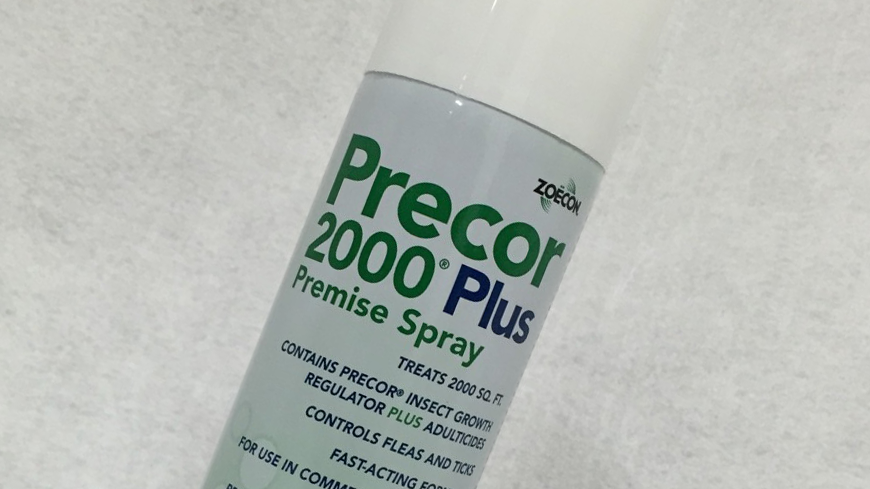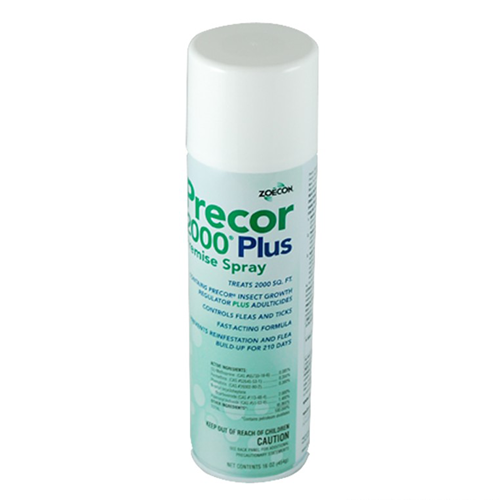Summary
Precor 2000 Plus is a premise spray used for killing fleas, ticks, and other indoor pests. It quickly kills adult fleas with pyrethrins. While eggs and larvae are inhibited from maturing with methoprene. Methoprene remains active indoors and prevents re-infestation for 7 months.
Precor 2000 Plus
Precor 2000 Plus controls and prevents fleas for 7 months indoors.
Precor 2000 Plus is similar to other premise sprays that contain analogous active ingredients. The most significant difference between competitors is price, and Precor 2000 Plus is the least expensive.
| Product name | Precor 2000 Plus Premise Spray |
| Active ingredients | 0.085% (s)-methoprene 0.350% permethrin 0.300% phenothrin 2.000% MGK 264 1.750% piperonyl butoxide 95.515% other ingredients |
| Target pest | Fleas & ticks |
| Kills | Adults, eggs & larvae |
| Duration | 7 months |
| Size | 16 ounces |
| Capacity | 2000 sq ft |
| Application | Aerosol spray |
| Use on | Home premises |
| Manufacturer | Zoecon |
| UPC | 041535063016 |
| Product label | view |
| MSDS | view |
| Shop | Amazon.com |
| Price | $19 |
| Customer reviews | Read reviews |
| Competitors | Browse premise sprays |
- Prices are based on Amazon.com at time of publishing.
Details
How Precor 2000 Plus Works
Methoprene
Zoecon’s Precor 2000 Plus uses an insect growth regulator (IGR) called (s)-methoprene. The common name of this compound is Precor, and it’s manufactured by Zoecon. The IGR will prevent flea eggs and larvae from reaching adulthood. Methoprene mimics an endogenous insect hormone called juvenile hormone. When present, the hormone, or its mimic, will prevent immature insects from metamorphosing into adults. In addition, exposed adult females can’t lay viable eggs.
Methoprene is the most important active ingredient in Precor 2000 Plus. This is because 95-99% of flea populations are eggs, larvae, and pupae living in the environment. They often reside deep within carpets where sprays can’t penetrate well. Adulticides aren’t effective in killing these stages, because, along with the penetration issue, they have a short-lived effect. IGRs, on the other hand, will remain active indoors for 7 months. This long-lasting residual activity plays a crucial role in efficacy.
Permethrin & Phenothrin
The adulticides in Precor 2000 Plus are permethrin and phenothrin. They belong to a class of insecticides called pyrethroids, which are synthetic compounds based on a botanical insecticide found in Chrysanthemum flowers (pyrethrum). Pyrethroids are commonly used to kill pest insects in homes. These insecticides are neurotoxins. They work by affecting an insect’s nervous system, causing spasms, paralysis, and ultimately death.
Precor 2000 Plus will quickly kill exposed adult fleas in the environment. Unfortunately, only 1-5% of flea populations are adults. And most adults lives on their animal host. Once they find a host, they stay there. Only a small portion of adult fleas will be found emerging from their cocoons in the environment.
A large portion of immature fleas won’t be affected by the spray. This is because they live at the base of carpets. The carpet canopy protects the developing fleas from insecticide penetration and vacuum removal. In time, these young fleas will emerge as adults. This can cause confusion and give the false impression that the premise spray didn’t work. However, this should be the last generation of adults. Any further eggs that fall into the IGR-treated carpets shouldn’t be able to survive.
MGK 264 & Piperonyl butoxide
Precor 2000 Plus contains two synergists, piperonyl butoxide and N-octyl bicycloheptene dicarboximide (MGK 264). Synergists don’t have any insecticidal properties themselves, but they boost the potency of pyrethrins and pyrethroids. Thus, they are often found together in pest sprays. The synergists allow less insecticide to be used, which results in safer, cheaper products.
Precor 2000 Plus
Precor 2000 Plus is the cheapest spray among close competitors (may change).
Competitor Comparison
The primary competitors of Precor 2000 Plus are Siphotrol Plus II, Virbac Knockout E.S., and PT Ultracide. All of these premise sprays are closely related in terms of active ingredient formulation. What makes Precor 2000 Plus stand out from its competitors is price. Precor offer the most value. This cost savings may be explained by Zoecon manufacturing both the spray and the active ingredient it contains.
Instructions
The following instructions were taken from the product label of Precor 2000 Plus. Before using the product, view the label for the full directions and precautionary statements.
READ ENTIRE LABEL BEFORE USE. NOT FOR USE ON HUMANS OR PETS.
Directions for Use
It is a violation of Federal Law to use this product in a manner inconsistent with its labeling. SHAKE WELL BEFORE USING.
FOR USE IN THE HOME/GARAGE/KENNEL
Identify treatment areas, especially those where pets frequent, such as in and around pet’s sleeping and resting areas. These are the primary areas where fleas, their eggs, and ticks are found. Before treatment, make a test application to upholstery, drapery, lightcolored, delicate fabrics, or wood surfaces in an inconspicuous place.
Prepare treatment areas. Remove pets and birds, and cover and unplug fish aquariums before spraying. Remove motor vehicles before using in garages. For best results with Surface/Carpet treatments, vacuum thoroughly before spraying and discard vacuum bag in outside trash. This product may also be used for infested surfaces inside motor vehicles.
Apply treatment. For flea/tick infestations, a single 16 oz. can treats 2000 square feet (22 oz. can treats 2750 square feet). Hold container upside down 2-3 feet from surface, point actuator towards the surface and push button. Using a sweeping motion, apply a light uniform spray to all surfaces of furniture, rugs, carpets, drapes, and around all pet resting areas. Mist treated areas only until “slightly damp”. Reapply in 14 days, if necessary. IMPORTANT: Only complete and proper application to carpets, upholstery, drapes, and other fabrics will provide thorough flea/tick elimination. Keep people and pets out of areas during treatment. Do not apply directly to pets or animals. Vacate room after treatment, and ventilate until surfaces are dry before reoccupying. To eliminate fleas/ticks on your pets, only use products approved for such uses, such as Petcor® Flea Spray.
For use in: Hospitals, Hotels, Motels, Offices, Schools, Supermarkets, Transportation Equipment (Buses, Boats, Ships, Trains, Trucks), Warehouses, Utilities, Veterinary Clinics and Other Commercial and Industrial Buildings:
Prepare Treatment Areas. For best results with Surface/Carpet treatments, vacuum thoroughly before spraying and discard vacuum bag in outside trash. Test in an inconspicuous area before treating. Keep people and pets out of areas during treatment. Cover and unplug aquariums before spraying. Thoroughly ventilate until surfaces are dry before reoccupying.
Apply Treatment. For flea/tick infestations, a single 16 oz. can treats 2000 square feet (22 oz. can treats 2750 square feet). Hold container upside down 2-3 feet from surface, point actuator towards the surface and push button. Using a sweeping motion, apply a light uniform spray to all surfaces of furniture, rugs, carpets, drapes, and around all pet resting areas. Mist treated areas only until “slightly damp”. Reapply in 14 days, if necessary. IMPORTANT: Only complete and proper application to carpets, upholstery, drapes, and other fabrics will provide thorough flea/tick elimination. For cockroaches: Spray into hiding places, such as cracks, crevices, behind sinks, cabinets, along baseboards and floors, around drains and plumbing, hitting insects with spray whenever possible. For ants: Spray trails, nests, and points of entry. Spray on ants where possible.
Storage and Disposal
Do not contaminate water, food, or feed by storage or disposal. Pesticide Storage: Store in a cool, dry area. Do not transport or store below 32° F. Container Handling and Disposal: Do Not Puncture or Incinerate! If empty: Place in trash or offer for recycling if available. If partly filled: Call your local solid waste agency for disposal instructions.
Tips for Success
Target Hot-Spots
Flea eggs are laid on the host, but fall within a few hours. They can end up anywhere the host wanders, but most end up concentrated in areas frequented by the animal. Flea hot-spots often develop where pets sleep, groom, and eat. Hot-spots are usually found near beds in bedrooms, and near seating or pet beds in living rooms.
While spraying, be thorough and diligent about applying the treatment to the entire room. However, give special attention to where hot-spots are likely to occur. If follow-up treatments are required, then spraying can be limited to the identified hot-spots to eradicate the last fleas.
Have Realistic Expectations
Having realistic expectations is crucial. It can reduce frustration and stress. There’s no product or method that will immediately cure a flea infestation. Immature stages make up the bulk of infestations and live deep within carpets where sprays and vacuums can’t penetrate. Patience is required. These stages need to mature, emerge as adults, and then die. Once they do, those adults should be the last generation. Thus, seeing new adults after spraying is common, and not an indication that the treatment failed. Infestations typically take at least 2 months to completely resolve after proper treatment.
Pre-Emerged Adults
Pre-emerged adult fleas are a troublesome stage. After pupating, adults can elect to stay inside their cocoons in a quiescent (sleep-like) state for up to 5 months. However, they’ll quickly wake up and emerge upon detecting heat and pressure (usually a host) on the cocoon. Vacuuming can simulate these host cues and force emergence.
Vacuuming Procedure
Before spraying, vacuum the carpets thoroughly. Vacuuming lifts up carpet fibers so insecticide can penetrate deeper into the matrix. After spraying, wait until the carpets are dry before vacuuming again. Then vacuum at least every other day. Dry vacuuming won’t reduce the efficacy of flea insecticides. It may actually improve efficacy, as cocooned adults are triggered to emerge into the pesticide.
Premise Sprays Aren’t Enough
Adult fleas account for 1-5% of infestations. Once they jump onto a host, they stay on the animal. Carpets treatments won’t kill the adults living on untreated dogs or cats. Thus, the infestation won’t end. Each female lays around 25 eggs a day. If eggs manage to fall onto any untreated surface, then the infestation will thrive.
This is why integrated flea control is the best approach. By attacking the fleas on multiple fronts (environment and pets) with different tactics (insecticides, vacuuming, sanitation) establishing and maintaining control is easiest.






You must log in to post a comment. Log in now.
A+++ to the recommendation of Precor 2000 plus. After several attempts at bombing with different brands of bombing agent, this product put them ALL to shame. After each bombing the apartment would be flea free for 1 or 2 days. Then right back to the infestation stage by 3rd or 4th day. 30 to 40 fleas hungry for dinner would attack upon entering the WOOD FLOOR LIVINGROOM and the carpeted areas were even worse! 4 cans coating the entire floor and 10 inches, or so, of the lower walls. Not a single flea since and it’s been over a week! You know your stuff! Thanks for the website, information and mostly the help with my flea infested apartment!
Do you have an update to your success story now that it has been a few weeks later?
I just broadcast sprayed Precor IGR concentrate and sprayed Precor 2000 Plus this morning. We have hardwood floor and three 8 by 10 carpets that have been harboring fleas. I covered the carpets and some of the hardwood floor where I’ve noticed them and haven’t seen since. The infestation has been consistent for a few weeks despite constant vacuuming and flea combing the cat. We find 5-10 on her twice a day and a couple jumping on us throughout the day.
Could use some reassurance from someone going through a similar situation that is a few weeks ahead of the process than us.
Does Precor kill Knats & does it hurt flowers?
It should work on most insects. However, this website is specific to fleas. There is no information on the product label about the effect on plants and flowers.